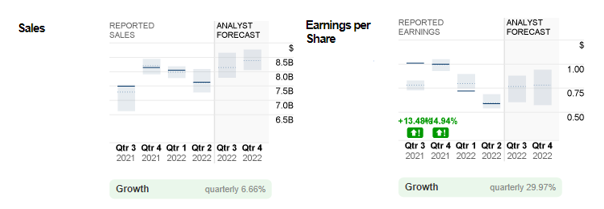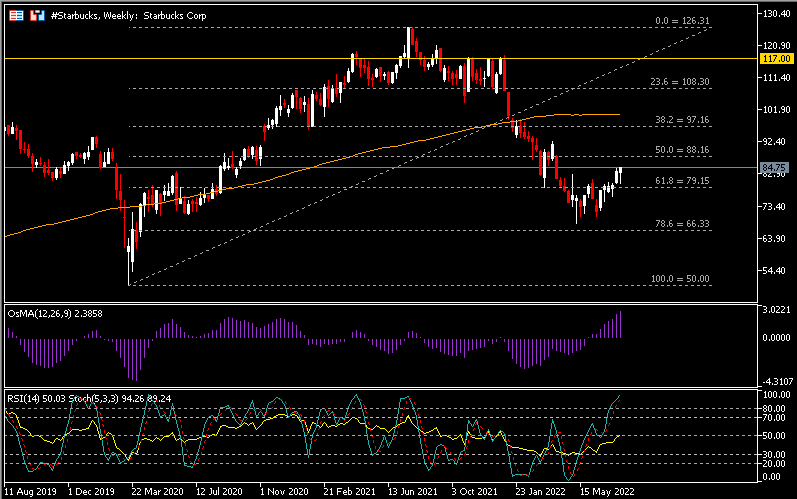The world’s largest coffeehouse chain committed to being the premier roaster and retailer of specialty coffee – Starbucks – is scheduled to report its Q3 2022 financial results this Tuesday (2nd August), after market close.
Fig.1: Reported Sales and EPS versus Analyst Forecast for Starbucks.
Source: money.cnn
In the previous quarter, Starbucks sales aligned with consensus estimates at $7.6B, however earnings per share (EPS) underperformed at only $0.59, below analysts expectation by nearly -30%. Both sales and EPS were down -6.17% and -18.06% respectively compared to those in Q1 2022. The disappointing results were mainly weighed down by an international shrinkage in sales especially in China, the company’s second-largest market, in which a resurgence of the coronavirus and new lockdowns caused a temporary closing of stores.
The catastrophe may not end very soon. Recently reimposed Covid restrictions by the Chinese government in pursuit of its ‘zero Covid’ policy have presented more challenges for hospitality businesses including Starbucks. The management’s aim to reach 6,000 stores (currently over 5,400) in China by the end of this year is now in doubt due to various uncertainties. Comparatively, US stores performed much better, with sales +12% versus international comparable store sales at -8%. Active membership of the Starbucks loyalty program in the US also reported an increase of 17% to 26.7 million customers in the second quarter.
Consensus estimates towards sales in Q3 remains positive, at $8.1B, up 6.58% (q/q) and 8% (y/y), while EPS is expected to hit $0.77, up over 30% from the previous quarter, but slightly down -23.77% from the same quarter last year. Besides the existing unfavorable macroeconomic factors (Fed rate hike, recession risk, supply chain issues, competitors, etc), recent issues related to safety concerns which have led to closure of 16 stores in the US may serve as a headwind for the coffee conglomerate in the near future. The management responded to the issue earlier by stating a few measures to implement, including doubling the hours of training in conflict de-escalation (disruptive patrons (usually those who are homeless and/or suffering from mental health issues), drugs abuse in the bathrooms, smashed windows), evaluation of modifying operations to align with new safety goals, implementation of the Starbucks Outreach Worker Program to embed social workers in stores with high level challenges, etc.
Technical Analysis:
The #Starbucks share price managed to lift off its recent lows ($68.37), with gains nearly 24%. FR 50.0% (extended from 15th March 2020 lows to 18th July 2021 highs) at $88.16, or median estimates of analysts at $89 serve as the nearest resistance to watch. Breaking above these levels may bring the bulls towards testing the next resistance at $97.16, the 100-Weekly SMA, and $108.30. Otherwise, $79.15 serves as the nearest support. A close below this level may encourage more downward pressures, into testing the next support at $66.33 and psychological level at $60. OsMA value: 2.3858; RSI: 48.53; Stochastics: above 80 (overbought).
Click here to access our Economic Calendar
Larince Zhang
Market Analyst
Disclaimer: This material is provided as a general marketing communication for information purposes only and does not constitute an independent investment research. Nothing in this communication contains, or should be considered as containing, an investment advice or an investment recommendation or a solicitation for the purpose of buying or selling of any financial instrument. All information provided is gathered from reputable sources and any information containing an indication of past performance is not a guarantee or reliable indicator of future performance. Users acknowledge that any investment in Leveraged Products is characterized by a certain degree of uncertainty and that any investment of this nature involves a high level of risk for which the users are solely responsible and liable. We assume no liability for any loss arising from any investment made based on the information provided in this communication. This communication must not be reproduced or further distributed without our prior written permission.





















